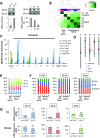Small RNA-mediated repair of UV-induced DNA lesions by the DNA DAMAGE-BINDING PROTEIN 2 and ARGONAUTE 1
- PMID: 28325872
- PMCID: PMC5389294
- DOI: 10.1073/pnas.1618834114
Small RNA-mediated repair of UV-induced DNA lesions by the DNA DAMAGE-BINDING PROTEIN 2 and ARGONAUTE 1
Abstract
As photosynthetic organisms, plants need to prevent irreversible UV-induced DNA lesions. Through an unbiased, genome-wide approach, we have uncovered a previously unrecognized interplay between Global Genome Repair and small interfering RNAs (siRNAs) in the recognition of DNA photoproducts, prevalently in intergenic regions. Genetic and biochemical approaches indicate that, upon UV irradiation, the DNA DAMAGE-BINDING PROTEIN 2 (DDB2) and ARGONAUTE 1 (AGO1) of Arabidopsis thaliana form a chromatin-bound complex together with 21-nt siRNAs, which likely facilitates recognition of DNA damages in an RNA/DNA complementary strand-specific manner. The biogenesis of photoproduct-associated siRNAs involves the noncanonical, concerted action of RNA POLYMERASE IV, RNA-DEPENDENT RNA POLYMERASE-2, and DICER-LIKE-4. Furthermore, the chromatin association/dissociation of the DDB2-AGO1 complex is under the control of siRNA abundance and DNA damage signaling. These findings reveal unexpected nuclear functions for DCL4 and AGO1, and shed light on the interplay between small RNAs and DNA repair recognition factors at damaged sites.
Keywords: Arabidopsis; DNA photolesions; DNA repair; small RNA.
Conflict of interest statement
The authors declare no conflict of interest.
Figures













Similar articles
-
Roles of dicer-like and argonaute proteins in TAS-derived small interfering RNA-triggered DNA methylation.Plant Physiol. 2012 Oct;160(2):990-9. doi: 10.1104/pp.112.200279. Epub 2012 Jul 30. Plant Physiol. 2012. PMID: 22846193 Free PMC article.
-
Global Genome Repair factors controls DNA methylation patterns in Arabidopsis.Plant Signal Behav. 2016 Dec;11(12):e1253648. doi: 10.1080/15592324.2016.1253648. Plant Signal Behav. 2016. PMID: 27813706 Free PMC article.
-
RETRACTED: Small RNA duplexes function as mobile silencing signals between plant cells.Science. 2010 May 14;328(5980):912-6. doi: 10.1126/science.1185880. Epub 2010 Apr 22. Science. 2010. Retraction in: Science. 2016 Oct 14;354(6309):190. doi: 10.1126/science.aai9397. PMID: 20413458 Retracted.
-
The expanding world of small RNAs in plants.Nat Rev Mol Cell Biol. 2015 Dec;16(12):727-41. doi: 10.1038/nrm4085. Epub 2015 Nov 4. Nat Rev Mol Cell Biol. 2015. PMID: 26530390 Free PMC article. Review.
-
Recent advances in plant-virus interaction with emphasis on small interfering RNAs (siRNAs).Mol Biotechnol. 2013 Sep;55(1):63-77. doi: 10.1007/s12033-012-9615-7. Mol Biotechnol. 2013. PMID: 23086491 Review.
Cited by
-
The plant siRNA landscape.Plant Cell. 2024 Jan 30;36(2):246-275. doi: 10.1093/plcell/koad253. Plant Cell. 2024. PMID: 37772967 Free PMC article. Review.
-
Genome-wide analysis of CCHC-type zinc finger (ZCCHC) proteins in yeast, Arabidopsis, and humans.Cell Mol Life Sci. 2020 Oct;77(20):3991-4014. doi: 10.1007/s00018-020-03518-7. Epub 2020 Apr 18. Cell Mol Life Sci. 2020. PMID: 32303790 Free PMC article. Review.
-
Formation and Recognition of UV-Induced DNA Damage within Genome Complexity.Int J Mol Sci. 2020 Sep 12;21(18):6689. doi: 10.3390/ijms21186689. Int J Mol Sci. 2020. PMID: 32932704 Free PMC article. Review.
-
Decoding the Virtual 2D Map of the Chloroplast Proteomes.Biol Proced Online. 2022 Dec 13;24(1):23. doi: 10.1186/s12575-022-00186-8. Biol Proced Online. 2022. PMID: 36513972 Free PMC article.
-
Chromatin Remodeling and Epigenetic Regulation in Plant DNA Damage Repair.Int J Mol Sci. 2019 Aug 22;20(17):4093. doi: 10.3390/ijms20174093. Int J Mol Sci. 2019. PMID: 31443358 Free PMC article. Review.
References
-
- Schreier WJ, Gilch P, Zinth W. Early events of DNA photodamage. Annu Rev Phys Chem. 2015;66:497–519. - PubMed
-
- Sancar A. Photolyase and cryptochrome blue-light photoreceptors. Adv Protein Chem. 2004;69:73–100. - PubMed
-
- Chu G, Chang E. Xeroderma pigmentosum group E cells lack a nuclear factor that binds to damaged DNA. Science. 1988;242:564–567. - PubMed
-
- Nichols AF, et al. Human damage-specific DNA-binding protein p48. Characterization of XPE mutations and regulation following UV irradiation. J Biol Chem. 2000;275:21422–21428. - PubMed
Publication types
MeSH terms
Substances
LinkOut - more resources
Full Text Sources
Other Literature Sources
Molecular Biology Databases
Research Materials

